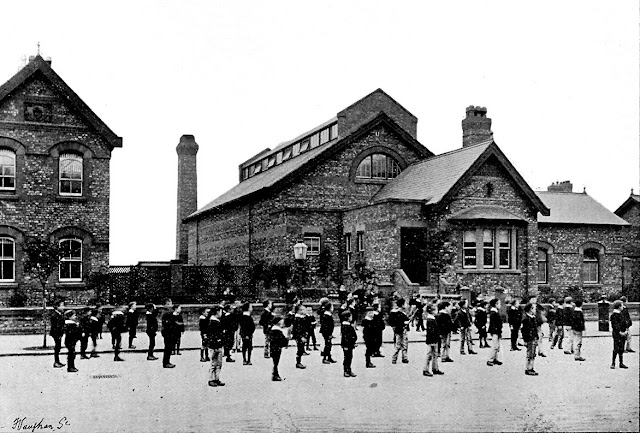 |
| Cottage Homes, Fazakerley - 1894 |
New Hall Hospital was part of the cottage homes complex, the Fazakerley Cottage Homes, and was built on Longmoor Lane between 1887 and 1889 by Charles H. Lancaster for the West Derby Poor Law Union, also designing the buildings at Low Hill and Alder Hey. John Houlding, one time president of Everton Football Club and famously the founder of Liverpool Football Club, following the split with Everton, was the chair of the West Derby Poor Law Union, or the Board of Guardians, which was basically like the council of the day.
The site consisted of a broad avenue lined with a row of two-storey brick cottages. At the entrance to the avenue was the former superintendent's house and a probationary ward. In the centre of the avenue towards the end was a square containing the Hall, and the surrounding buildings included a swimming bath and service buildings. The identical cottages had a gabled five-bay frontage and an H-shaped plan. The Hall itself was a large building in red brick with sandstone dressings, with tall round-headed windows along the sides. The front, facing Longmoor Lane, had a portico with a pediment on Corinthian pilasters above which stood the prominent clock tower.
This would be the start of a number of medical institutions in the immediate area. The intention was to create a place where orphans and children from the West Derby Workhouse, whose
parents were unable to take care of them, would gain an education and
training (in such areas as carpentry, metalwork or grocering). On the site there were schools, a swimming pool, farm buildings and gardens. They
would also benefit from on-site health care from resident doctors. There were 24 cottages in the complex each of which could house up to 25
children - a grand total of 600 children. Each 'Cottage' was overseen by a different House-Mother and the children’s experiences of living there varied greatly depending on
the approach to 'care' favoured by their House-Mother. Money
for the institution came from the sale of Union-owed land to the
Liverpool and Yorkshire Railway. In 1930, the Boards of Guardians, who had administered the poor relief
system in England and Wales since 1834, were abolished and their
responsibilities were taken over by county and county borough councils.
Each council set up a Public Assistance Committee to oversee its new
duties, which included the operation of the various children's
establishments previously run by the poor law unions in each area.
 |
| Historic photo of the Clock Tower Park development in Fazakerley, 1889(Image: Oliver Craven) |
One of Fazakerley’s characteristics was as the location for a series of healthcare institutions. In 1898, the Liverpool Corporation bought the Harbreck House Estate for one of a series of new hospitals. This one was to be called City Hospital North, and opened in three phases. The first was a set of wooden buildings on the fields of the former Harbreck Farm of Higher Lane (in 1901). The second was brick-built, and opened in 1906 near to the first set of buildings. In 1913 the third phase began on Sparrowhall Farm land. This was known commonly as the 'Sparrowhall Hospital', though its official name was the Infection Diseases Hospital.
In 1914, with the outbreak of the First World War, the hospital complex was taken over by the military to treat sick and injured soldiers. In this guise it was known as the 1st Western Military Hospital, and remained in the hands of the armed forces until the end of the conflict.
 |
| This child-sized post box was specially made for the children at Fazakerley Cottage Homes to post their letters and cards. |
The Liverpool Council's Public Assistance Committee took over Fazakerley Cottage Homes and by 1947, a hostel for girls from the cottage homes had been opened on Longmoor Lane. Along with other Workhouse Union buildings, the Cottage Homes became a hospital with the formation of the NHS in 1948. The last child left in 1964 when it changed to Newhall Hostels for a period of nearly 20 years after this, followed by care and social services before the homes later fell into disrepair.
see also :- http://www.thefootballvoice.com/2025/06/liverpool-hospitals-rathbone-hospital.html

No comments:
Post a Comment